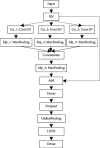Automatic Detection of Obstructive Sleep Apnea Events Using a Deep CNN-LSTM Model
- PMID: 33859679
- PMCID: PMC8009718
- DOI: 10.1155/2021/5594733
Automatic Detection of Obstructive Sleep Apnea Events Using a Deep CNN-LSTM Model
Abstract
Obstructive sleep apnea (OSA) is a common sleep-related respiratory disorder. Around the world, more and more people are suffering from OSA. Because of the limitation of monitor equipment, many people with OSA remain undetected. Therefore, we propose a sleep-monitoring model based on single-channel electrocardiogram using a convolutional neural network (CNN), which can be used in portable OSA monitor devices. To learn different scale features, the first convolution layer comprises three types of filters. The long short-term memory (LSTM) is used to learn the long-term dependencies such as the OSA transition rules. The softmax function is connected to the final fully connected layer to obtain the final decision. To detect a complete OSA event, the raw ECG signals are segmented by a 10 s overlapping sliding window. The proposed model is trained with the segmented raw signals and is subsequently tested to evaluate its event detection performance. According to experiment analysis, the proposed model exhibits Cohen's kappa coefficient of 0.92, a sensitivity of 96.1%, a specificity of 96.2%, and an accuracy of 96.1% with respect to the Apnea-ECG dataset. The proposed model is significantly higher than the results from the baseline method. The results prove that our approach could be a useful tool for detecting OSA on the basis of a single-lead ECG.
Copyright © 2021 Junming Zhang et al.
Conflict of interest statement
The authors declare that they have no conflicts of interest.
Figures









Similar articles
-
SCNN: Scalogram-based convolutional neural network to detect obstructive sleep apnea using single-lead electrocardiogram signals.Comput Biol Med. 2021 Jul;134:104532. doi: 10.1016/j.compbiomed.2021.104532. Epub 2021 May 29. Comput Biol Med. 2021. PMID: 34102402
-
A Sleep Apnea Detection System Based on a One-Dimensional Deep Convolution Neural Network Model Using Single-Lead Electrocardiogram.Sensors (Basel). 2020 Jul 26;20(15):4157. doi: 10.3390/s20154157. Sensors (Basel). 2020. PMID: 32722630 Free PMC article.
-
ECG-based convolutional neural network in pediatric obstructive sleep apnea diagnosis.Comput Biol Med. 2023 Dec;167:107628. doi: 10.1016/j.compbiomed.2023.107628. Epub 2023 Oct 24. Comput Biol Med. 2023. PMID: 37918264 Free PMC article.
-
Advancements in Home-Based Devices for Detecting Obstructive Sleep Apnea: A Comprehensive Study.Sensors (Basel). 2023 Nov 30;23(23):9512. doi: 10.3390/s23239512. Sensors (Basel). 2023. PMID: 38067885 Free PMC article. Review.
-
Diagnostic accuracy of level IV portable sleep monitors versus polysomnography for obstructive sleep apnea: a systematic review and meta-analysis.Sleep Breath. 2018 Sep;22(3):593-611. doi: 10.1007/s11325-017-1615-1. Epub 2018 Jan 9. Sleep Breath. 2018. PMID: 29318566
Cited by
-
Advanced sleep disorder detection using multi-layered ensemble learning and advanced data balancing techniques.Front Artif Intell. 2025 Jan 28;7:1506770. doi: 10.3389/frai.2024.1506770. eCollection 2024. Front Artif Intell. 2025. PMID: 39935613 Free PMC article.
-
MCFN: A Multichannel Fusion Network for Sleep Apnea Syndrome Detection.J Healthc Eng. 2023 Jan 23;2023:5287043. doi: 10.1155/2023/5287043. eCollection 2023. J Healthc Eng. 2023. PMID: 36726772 Free PMC article.
-
Sex differences in rTMS treatment response: A deep learning-based EEG investigation.Brain Behav. 2022 Aug;12(8):e2696. doi: 10.1002/brb3.2696. Epub 2022 Jul 25. Brain Behav. 2022. PMID: 35879921 Free PMC article.
-
Obstructive sleep apnea event detection using explainable deep learning models for a portable monitor.Front Neurosci. 2023 Jul 14;17:1155900. doi: 10.3389/fnins.2023.1155900. eCollection 2023. Front Neurosci. 2023. PMID: 37521695 Free PMC article.
-
A Comprehensive Review: Computational Models for Obstructive Sleep Apnea Detection in Biomedical Applications.Biomed Res Int. 2022 Feb 16;2022:7242667. doi: 10.1155/2022/7242667. eCollection 2022. Biomed Res Int. 2022. Retraction in: Biomed Res Int. 2023 Dec 29;2023:9867624. doi: 10.1155/2023/9867624. PMID: 35224099 Free PMC article. Retracted. Review.
References
-
- Iber C., Ancoli-Israel S., Chesson A. L., et al. The AASM Manual for the Scoring of Sleep and Associated Events: Rules, Terminology and Technical Specifications. Darien, IL, USA: American Academy of Sleep Medicine; 2007. pp. 17–48.
MeSH terms
LinkOut - more resources
Full Text Sources
Other Literature Sources
Medical

